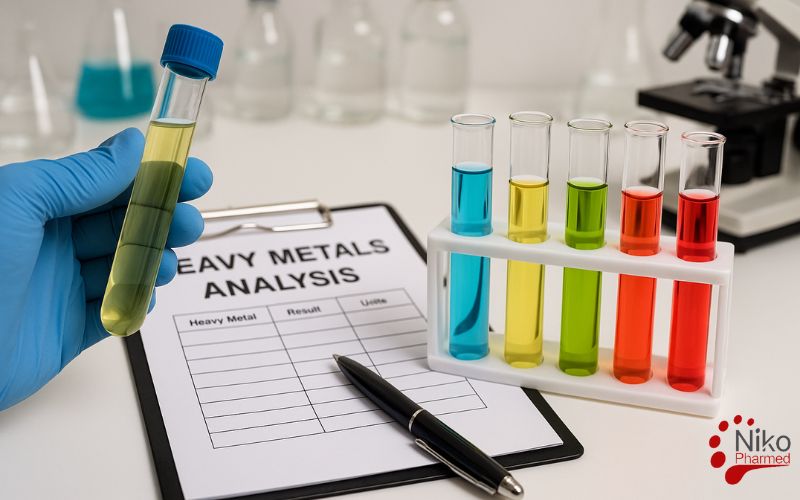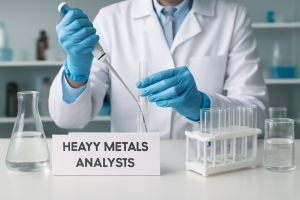What is Heavy Metals Analysis?
Heavy metals analysis refers to the qualitative and quantitative determination of toxic and trace elements such as lead (Pb), mercury (Hg), cadmium (Cd), arsenic (As), chromium (Cr), and nickel (Ni) in diverse matrices including biological fluids, environmental samples, medical devices, and food products.
These metals are of particular concern due to their toxicity, persistence, and tendency to bioaccumulate, which can disrupt enzymatic pathways, impair vital organ function, and induce long-term health risks even at very low concentrations.
The primary purpose of heavy metals analysis is to assess safety, ensure compliance with regulatory standards, and evaluate potential health or environmental risks by determining whether concentrations fall within acceptable limits. As such, precise and reliable measurement of heavy metals is a cornerstone of toxicological studies, quality assurance, risk assessment, and public health protection. In comprehensive chemical safety programmes for plastics, food-contact materials and medical devices, heavy metals analysis is normally done with phthalates analysis to characterize both inorganic and organic contaminants
Heavy Metals Analysis Test Methods
Two of the most widely applied scientific methods for heavy metal analysis are Inductively Coupled Plasma (ICP) and Atomic Absorption Spectroscopy (AAS).
Inductively Coupled Plasma (ICP)
Inductively Coupled Plasma is a highly sensitive and multi-elemental analytical technique used to detect trace concentrations of metals and some non-metals.
The method employs a plasma torch, generated by argon gas and sustained by a high-frequency electromagnetic field, which reaches temperatures of 6,000–10,000 K. At these temperatures, the sample atoms are excited and ionized, producing characteristic emission spectra.
- ICP-OES (Optical Emission Spectrometry): Measures the light emitted by excited atoms and ions at element-specific wavelengths, allowing for simultaneous detection of multiple metals with excellent sensitivity and precision.
- ICP-MS (Mass Spectrometry): Detects the mass-to-charge ratio of ions generated in the plasma. This technique offers ultra-trace sensitivity (parts per trillion level) and isotopic analysis, making it the most powerful tool for comprehensive heavy metals monitoring.
Advantages:
Capable of detecting multiple elements simultaneously.
Very low detection limits (ppb to ppt).
Broad dynamic range and high reproducibility.
Suitable for complex matrices (biological, environmental, industrial).
Atomic Absorption Spectroscopy (AAS)
Atomic Absorption Spectroscopy is a selective technique for determining the concentration of individual metals based on the principle that ground-state atoms absorb light at specific wavelengths. The sample, usually atomized in a flame or graphite furnace, interacts with a hollow cathode lamp specific to the element of interest. The amount of light absorbed is directly proportional to the element’s concentration.
- Flame AAS: Utilizes an air-acetylene or nitrous oxide-acetylene flame as the atomization source. It is rapid and suitable for higher concentration ranges (ppm level).
- Graphite Furnace AAS (GFAAS): Uses an electrically heated graphite tube to atomize the sample, allowing for very small sample volumes and much higher sensitivity (ppb range) compared to flame AAS.
Advantages:
High specificity for single-element analysis.
Cost-effective compared to ICP.
Well-established, reliable, and widely used in regulatory laboratories.
Suitable for routine testing of targeted metals.
| Parameter | Inductively Coupled Plasma (ICP) | Atomic Absorption Spectroscopy (AAS) |
|---|---|---|
| Principle | Excitation/ionization of atoms in plasma followed by detection of emitted light (ICP-OES) or ions (ICP-MS). | Absorption of element-specific radiation by ground-state atoms in a flame or graphite furnace. |
| Techniques | ICP-OES (Optical Emission), ICP-MS (Mass Spectrometry). | Flame AAS, Graphite Furnace AAS (GFAAS). |
| Detection Range | Very low detection limits: ppb to ppt (especially with ICP-MS). | Flame AAS: ppm; Graphite Furnace AAS: ppb. |
| Sensitivity | Extremely high; can detect ultra-trace levels and isotopic ratios. | Moderate to high; limited compared to ICP but adequate for routine testing. |
| Number of Elements Analyzed | Multi-elemental: detects dozens of elements simultaneously. | Single-element: one element per lamp at a time. |
| Sample Throughput | High throughput; suitable for large-scale, multi-element analysis. | Lower throughput; slower for multiple elements due to lamp changes. |
| Sample Volume Requirement | Small amounts, but requires sample digestion/preparation. | Small amounts; Graphite Furnace AAS needs only microliters. |
| Matrix Compatibility | Handles complex matrices (biological, environmental, industrial). | More affected by matrix interferences; requires optimized conditions. |
| Precision & Accuracy | Very high; reproducible results with broad dynamic range. | Good for single-element but less precise in complex multi-element analysis. |
| Cost | High (instrumentation, gases, maintenance, operator training). | Lower cost, more accessible for routine labs. |
| Applications | Trace metals in biological samples, environmental monitoring, food safety, pharmaceutical and medical device testing, isotopic studies. | Routine monitoring of specific metals (Pb, Cd, Hg, etc.) in food, water, and industrial samples. |
| Regulatory Use | Often required for compliance with strict international standards (e.g., EU, FDA). | Still widely accepted for targeted regulatory testing, especially in food and water labs. |
Nikopharmed Heavy Metals Analysis
Laboratory Accreditation and Global Recognition
At Nikopharmed, our Heavy Metals Analysis services are conducted under ISO/IEC 17025 certification and ILAC accreditation, ensuring full compliance with internationally recognized standards of analytical quality and technical competence.
Technical Excellence and Validated Infrastructure
Our laboratory is equipped with state-of-the-art inductively coupled plasma systems (ICP-OES and ICP-MS) and advanced atomic absorption spectroscopy (AAS) platforms, enabling precise detection of trace metals such as lead (Pb), cadmium (Cd), mercury (Hg), arsenic (As), chromium (Cr), and nickel (Ni) in diverse and complex matrices. For medical devices and implantable products, heavy metals data contribute directly to chemical characterization and biocompatibility testing within the ISO 10993 framework, supporting biological risk assessment and regulatory submissions.
Regulatory-Ready Reporting and Timely Results
In industries where compliance and safety are non-negotiable, Nikopharmed provides rapid, accurate, and defensible heavy metals results. Our optimized analytical workflows guarantee fast turnaround times without compromising scientific rigor or regulatory compliance. Results are suitable for quality assurance programs, product certification, international trade inspections, regulatory submissions, and toxicological risk assessments.
Confidentiality and Data Integrity
All analyses are performed under legally binding non-disclosure agreements (NDAs), ensuring proprietary formulations, research data, and regulatory files remain fully protected. Each report is supported by a comprehensive audit trail, maintaining traceability, transparency, and absolute reliability.
Competitive Pricing with Uncompromised Quality
Nikopharmed offers cost-effective heavy metals analysis solutions tailored for small enterprises, multinational corporations, and regulatory agencies. With transparent pricing models, we help clients meet global compliance standards efficiently, accelerating regulatory approvals while maintaining uncompromised analytical accuracy and precision.
To request testing or a complimentary consultation contact Nikopharmad
Partner with Nikopharmed for Expert Heavy Metals Analysis
By choosing Nikopharmed, you gain access to a globally accredited laboratory dedicated to scientific excellence, regulatory compliance, and strict confidentiality. Whether ensuring product safety, verifying international quality standards, meeting import/export requirements, or conducting environmental and toxicological assessments, our heavy metals analysis expertise ensures accurate, reliable, and internationally recognized results—helping you achieve compliance with confidence.


